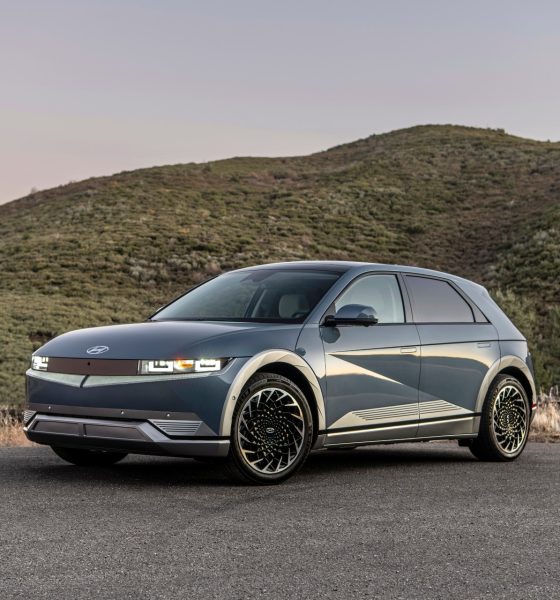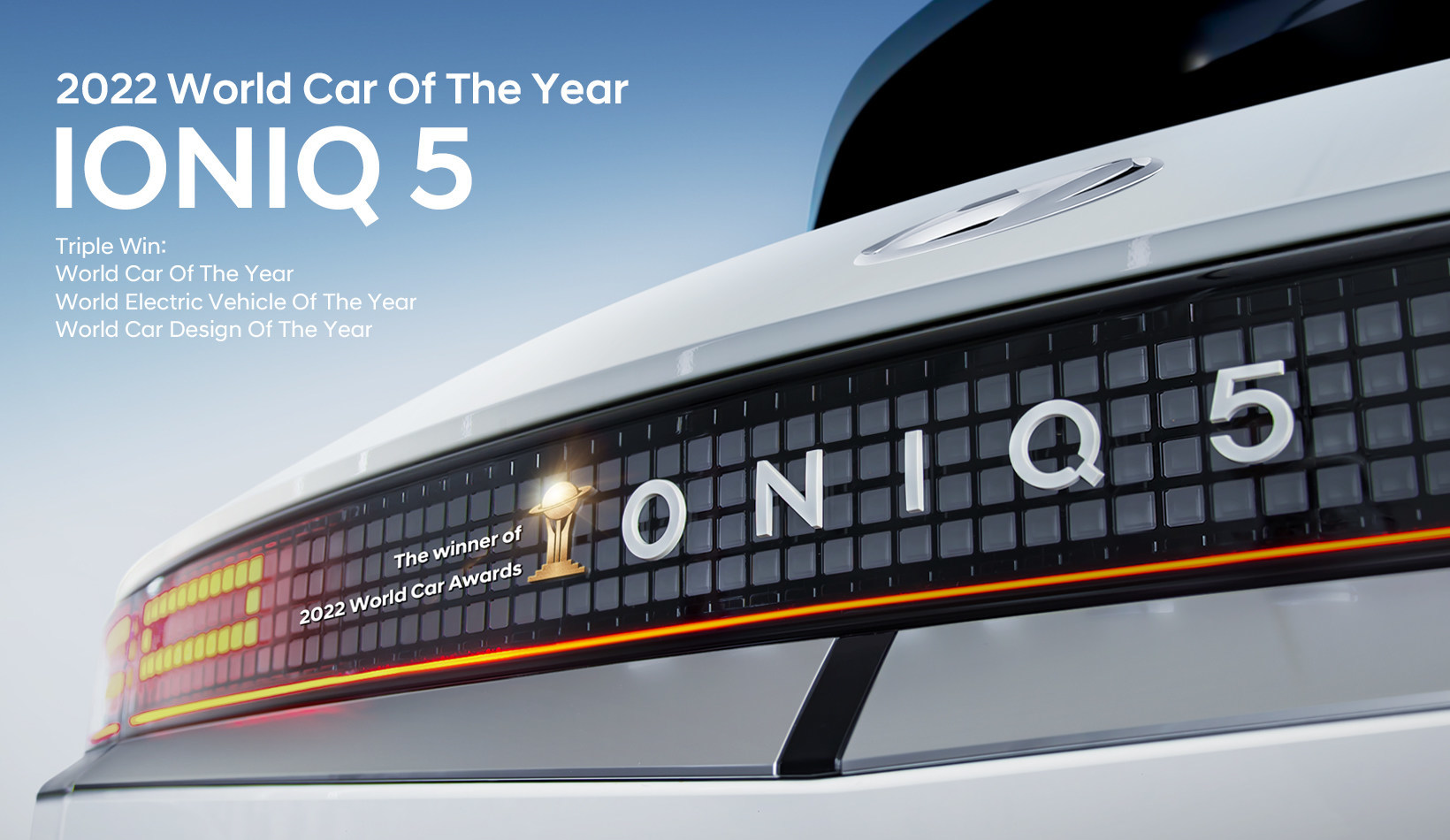

News
Hyundai IONIQ 5 wins Triple Crown of awards, including World Car of the Year, at NYIAS
The Hyundai IONIQ 5 all-electric crossover has claimed three new awards, including World Car of the Year, at the New York International Auto Show.
Recognized by a jury of 102 automotive journalists representing 33 different countries, the IONIQ 5 was recognized as World Car of the Year, World Electric Vehicle of the Year, and World Car Design of the Year during a ceremony at the NYIAS.
The highly acclaimed Hyundai IONIQ 5 won big at the prestigious 2022 World Car Awards today, with the all-electric crossover named overall World Car of the Year, World Electric Vehicle of the Year and World Car Design of the Year.
The IONIQ 5 beat out 27 competitor models, according to Hyundai, which launched the vehicle last year. Hyundai has sold over 6,200 units of the IONIQ 5 so far in 2022.
“We are truly honored to receive these prestigious awards, which recognize the talent and hard work of all our people and business partners at Hyundai Motor Company,” CEO and President Jaehoon Chang said. “Our vision is to enable Progress for Humanity, and this endorsement of our approach will serve to embolden our commitment to make this vision a reality.”
The IONIQ 5 is just one of several new fully electric models Hyundai plans to launch before the end of the decade. Hyundai plans to launch 17 new BEV models by 2030 under all of its brands, including Genesis. The company said it plans to sell at least 1.87 million BEVs units by the end of 2030.
Starting at $41,195, the Hyundai IONIQ 5 is a competitor to the Tesla Model Y and Ford Mustang Mach-E, among other all-electric crossovers on the market. A review of the vehicle from Car and Driver landed it a respectable score of 8.5 out of 10. Pros were the more than 300-mile range rating, the fast-charging capabilities, and world-class handling and ride quality. However, the fully-loaded IONIQ 5 will set customers back over $50,000, and the interior is not as flashy as you might find in other vehicles at that price point. Nevertheless, the IONIQ 5 is “a stylish EV hatchback with polite road manners,” the publication wrote.
The IONIQ 5, as previously mentioned, it one of the first steps of Hyundai’s venture into EVs. “IONIQ 5 represents a pivotal achievement for us as we pioneer a new generation of smart mobility solutions with our innovative E-GMP platform technologies, exceptional performance, and disruptive approach to design and space,” Chang said. “IONIQ 5 has made a strong impression on increasingly eco-conscious consumers around the world, and its success supports the acceleration of electrification of the automotive industry. The pace of change at Hyundai will continue unabated through the rest of 2022 as we will soon be adding to our award-winning IONIQ range.”
I’d love to hear from you! If you have any comments, concerns, or questions, please email me at joey@teslarati.com. You can also reach me on Twitter @KlenderJoey, or if you have news tips, you can email us at tips@teslarati.com.

News
Tesla starts showing how FSD will change lives in Europe
Local officials tested the system on narrow country roads and were impressed by FSD’s smooth, human-like driving, with some calling the service a game-changer for everyday life in areas that are far from urban centers.

Tesla has launched Europe’s first public shuttle service using Full Self-Driving (Supervised) in the rural Eifelkreis Bitburg-Prüm region of Germany, demonstrating how the technology can restore independence and mobility for people who struggle with limited transport options.
Local officials tested the system on narrow country roads and were impressed by FSD’s smooth, human-like driving, with some calling the service a game-changer for everyday life in areas that are far from urban centers.
Officials see real impact on rural residents
Arzfeld Mayor Johannes Kuhl and District Administrator Andreas Kruppert personally tested the Tesla shuttle service. This allowed them to see just how well FSD navigated winding lanes and rural roads confidently. Kruppert said, “Autonomous driving sounds like science fiction to many, but we simply see here that it works totally well in rural regions too.” Kuhl, for his part, also noted that FSD “feels like a very experienced driver.”
The pilot complements the area’s “Citizen Bus” program, which provides on-demand rides for elderly residents who can no longer drive themselves. Tesla Europe shared a video of a demonstration of the service, highlighting how FSD gives people their freedom back, even in places where public transport is not as prevalent.
What the Ministry for Economic Affairs and Transport says
Rhineland-Palatinate’s Minister Daniela Schmitt supported the project, praising the collaboration that made this “first of its kind in Europe” possible. As per the ministry, the rural rollout for the service shows FSD’s potential beyond major cities, and it delivers tangible benefits like grocery runs, doctor visits, and social connections for isolated residents.
“Reliable and flexible mobility is especially vital in rural areas. With the launch of a shuttle service using self-driving vehicles (FSD supervised) by Tesla in the Eifelkreis Bitburg-Prüm, an innovative pilot project is now getting underway that complements local community bus services. It is the first project of its kind in Europe.
“The result is a real gain for rural mobility: greater accessibility, more flexibility and tangible benefits for everyday life. A strong signal for innovation, cooperation and future-oriented mobility beyond urban centers,” the ministry wrote in a LinkedIn post.
News
Tesla China quietly posts Robotaxi-related job listing
Tesla China is currently seeking a Low Voltage Electrical Engineer to work on circuit board design for the company’s autonomous vehicles.

Tesla has posted a new job listing in Shanghai explicitly tied to its Robotaxi program, fueling speculation that the company is preparing to launch its dedicated autonomous ride-hailing service in China.
As noted in the listing, Tesla China is currently seeking a Low Voltage Electrical Engineer to work on circuit board design for the company’s autonomous vehicles.
Robotaxi-specific role
The listing, which was shared on social media platform X by industry watcher @tslaming, suggested that Tesla China is looking to fill the role urgently. The job listing itself specifically mentions that the person hired for the role will be working on the Low Voltage Hardware team, which would design the circuit boards that would serve as the nervous system of the Robotaxi.
Key tasks for the role, as indicated in the job listing, include collaboration with PCB layout, firmware, mechanical, program management, and validation teams, among other responsibilities. The role is based in Shanghai.
China Robotaxi launch
China represents a massive potential market for robotaxis, with its dense urban centers and supportive policies in select cities. Tesla has limited permission to roll out FSD in the country, though despite this, its vehicles have been hailed as among the best in the market when it comes to autonomous features. So far, at least, it appears that China supports Tesla’s FSD and Robotaxi rollout.
This was hinted at in November, when Tesla brought the Cybercab to the 8th China International Import Expo (CIIE) in Shanghai, marking the first time that the autonomous two-seater was brought to the Asia-Pacific region. The vehicle, despite not having a release date in China, received a significant amount of interest among the event’s attendees.
Elon Musk
Elon Musk and Tesla AI Director share insights after empty driver seat Robotaxi rides
The executives’ unoccupied tests hint at the rapid progress of Tesla’s unsupervised Robotaxi efforts.

Tesla CEO Elon Musk and AI Director Ashok Elluswamy celebrated Christmas Eve by sharing personal experiences with Robotaxi vehicles that had no safety monitor or occupant in the driver’s seat. Musk described the system’s “perfect driving” around Austin, while Elluswamy posted video from the back seat, calling it “an amazing experience.”
The executives’ unoccupied tests hint at the rapid progress of Tesla’s unsupervised Robotaxi efforts.
Elon and Ashok’s firsthand Robotaxi insights
Prior to Musk and the Tesla AI Director’s posts, sightings of unmanned Teslas navigating public roads were widely shared on social media. One such vehicle was spotted in Austin, Texas, which Elon Musk acknowleged by stating that “Testing is underway with no occupants in the car.”
Based on his Christmas Eve post, Musk seemed to have tested an unmanned Tesla himself. “A Tesla with no safety monitor in the car and me sitting in the passenger seat took me all around Austin on Sunday with perfect driving,” Musk wrote in his post.
Elluswamy responded with a 2-minute video showing himself in the rear of an unmanned Tesla. The video featured the vehicle’s empty front seats, as well as its smooth handling through real-world traffic. He captioned his video with the words, “It’s an amazing experience!”
Towards Unsupervised operations
During an xAI Hackathon earlier this month, Elon Musk mentioned that Tesla owed be removing Safety Monitors from its Robotaxis in Austin in just three weeks. “Unsupervised is pretty much solved at this point. So there will be Tesla Robotaxis operating in Austin with no one in them. Not even anyone in the passenger seat in about three weeks,” he said. Musk echoed similar estimates at the 2025 Annual Shareholder Meeting and the Q3 2025 earnings call.
Considering the insights that were posted Musk and Elluswamy, it does appear that Tesla is working hard towards operating its Robotaxis with no safety monitors. This is quite impressive considering that the service was launched just earlier this year.








